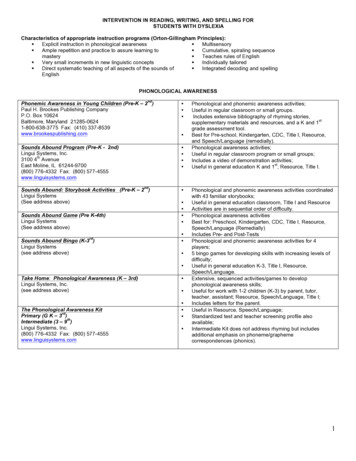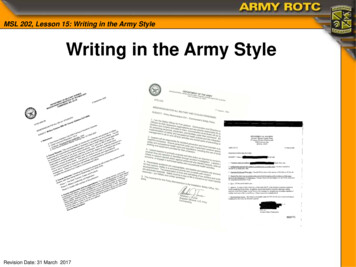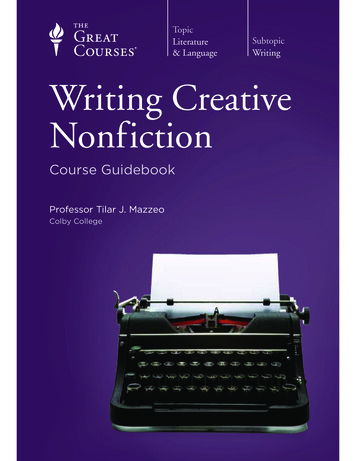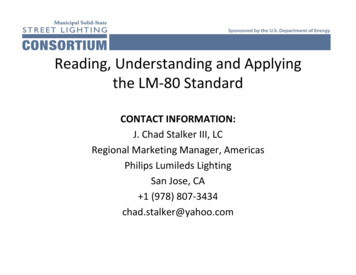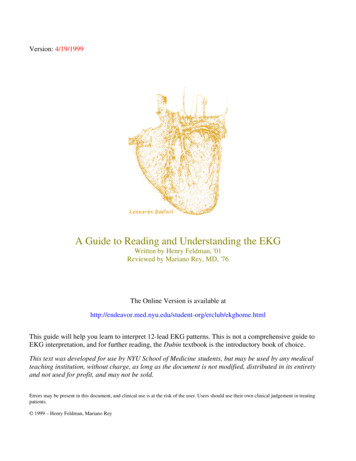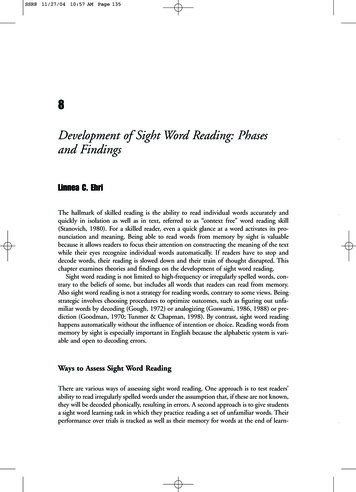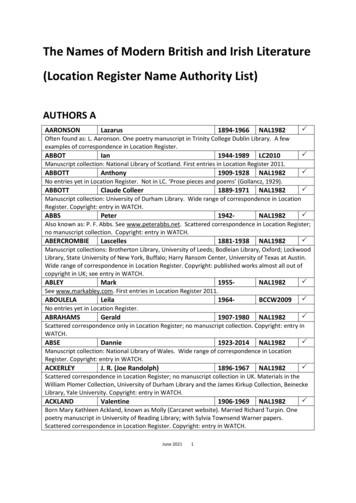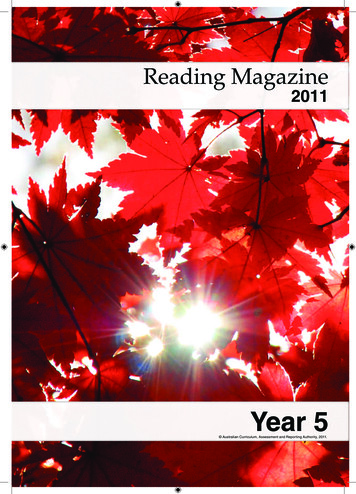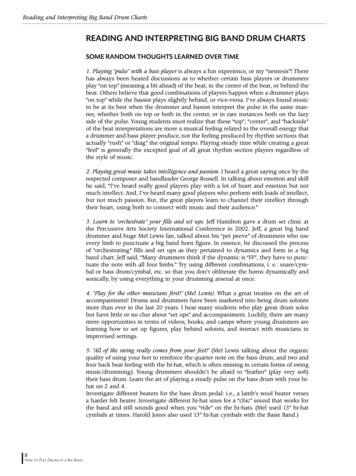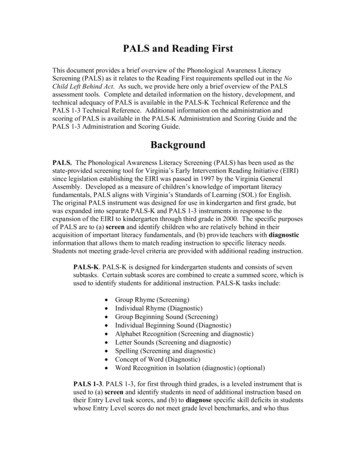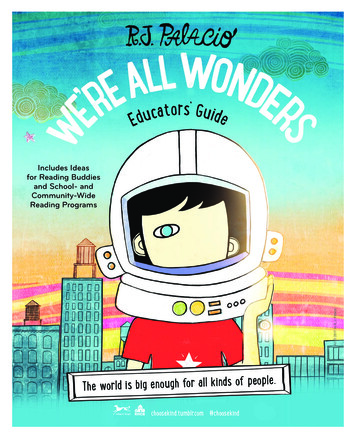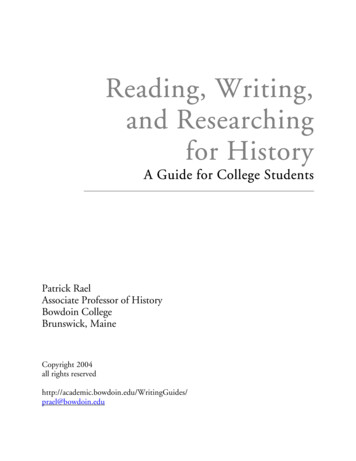
Transcription
Reading, Writing,and Researchingfor HistoryA Guide for College StudentsPatrick RaelAssociate Professor of HistoryBowdoin CollegeBrunswick, MaineCopyright 2004all rights prael@bowdoin.edu
Table of Contents1.Introductiona.b.c.2.Readinga.b.c.d.3.How to Read a Secondary SourceHow to Read a Primary SourcePredatory ReadingSome Keys to Good ReadingHistorical Argumentsa.b.c.d.e.4.IntroductionPreparing History Papers: the Short VersionAvoid Common Mistakes in Your History PaperArgument ConceptsAnalyzing ArgumentsHow to Ask Good QuestionsWhat Makes a Question Good?From Observation to HypothesisResearcha.b.c.d.Research PapersThe Research ProcessResearch BasicsKeeping a Research JournalReading, Writing, and Researching for HistoryPatrick Rael, Bowdoin College, 2004http://academic.bowdoin.edu/WritingGuides/3
5.Structuring Your Papera.b.c.d.6.Writing Your Papera.b.c.d.7.Presenting Primary Sources in Your PaperCiting SourcesAdvanced CitationEditing and Evaluationa.b.c.d.9.Grammar for HistoriansFormatting Your PaperA Style Sheet for History WritersThe Scholarly Voice: Crafting Historical ProseWorking with Sourcesa.b.c.8.Structuring Your EssayThe Three Parts of a History PaperThe ThesisHistory and RhetoricPaper-writing ChecklistPeer EvaluationsFrequent Grading CommentsGeneric Evaluation Rubric for PapersThe Writing Modela.b.Samples for PresentationSample Road MapReading, Writing, and Researching for HistoryPatrick Rael, Bowdoin College, 2004http://academic.bowdoin.edu/WritingGuides/4
1.a.IntroductionFor all who have taken history courses in college, the experience of writing a research paper is etchedindelibly in memory: late nights before the paper is due, sitting in pale light in front of a computermonitor or typewriter, a huge stack of books (most of them all-too-recently acquired) propped nextto the desk, drinking endless cups of coffee or bottles of Jolt cola. Most of all, we remember theendless, panicked wondering: how on earth was something coherent going to wind up on the page –let alone fill eight, or ten, or twelve of them? After wrestling with material for days, the pressure ofthe deadline and level of caffeine in the body rise enough, and pen is finally put to paper. Manyhours later, a paper is born – all too often something students are not proud to hand in, andsomething professors dread grading. "Whatever does not kill us makes us stronger." While Nietzschemay sometimes have been right, he likely did not have writing history papers in mind. On thecontrary, I sometimes wonder if students’ bad experiences writing papers does not drive some themaway from history. How can we make this process less traumatic, more educational, and ultimatelymore rewarding for all concerned?The assignment of preparing a research paper for a college-level history course is an important onewhich should not be neglected. In no other endeavor are so many history-related skills required ofstudents. Just think of the steps required:First, students must find a historical problem worth addressing. This is done most often by readingand comparing secondary history sources, such as monographs and journal articles. Simply findingrelevant secondary materials requires its own particular set of skills in using the library: searchingcatalogs, accessing on-line databases, using interlibrary loan, and even knowing how to posequestions to reference librarians. Reading these sources, determining their arguments, and puttingthem in conversation with each other constitute another broad set of skills which are enormouslydifficult to master.Second, having developed a historical problem, students must find a set of primary historical sourceswhich can actually address the question they have formulated. Once again, this is no easy task. Itrequires another array of skills in using the library. Students must know how to message the on-linelibrary catalog, and perhaps even (gasp!) use the card catalog. They must be willing to explore thestacks, learn to use special collections, travel off-campus to new libraries, or interview informants.Reading, Writing, and Researching for HistoryPatrick Rael, Bowdoin College, 2004http://academic.bowdoin.edu/WritingGuides/5
This kind of primary source research demands a diligence and persistence rare in these days of easyInternet access.Finally, students must put all this information together and actually produce knowledge. They mustcraft a paper wherein they pose a clear historical problem and then offer a thesis addressing it. In awell-structured, grammatically correct essay, they must work their way through an argument withoutfalling into common historical fallacies. They must match evidence to argument, subordinate littleideas to big ones, and anticipate and pre-empt challenges to their argument.Phew! It is little wonder that college history students, especially first-years and non-majors, can findthe research paper assignment so traumatic. It doesn’t help that history professors often have troubleteaching the essay-preparation process. This is understandable. History professors often representthat portion of the undergraduate population that "got it"; we are the students who somehow, oftenin spite of our professors, learned how to "do history." Having received the information virtuallythrough osmosis, we often do not understand how we think about the history-writing process, letalone how to teach it. By and large, we follow the advice of shoe companies and "just do it."Most students do not have it so easy. Many do not have the innate passion for the past whichpropelled history teachers over their steep learning curve. Many do not have learning styles whichmake them likely candidates for the "osmosis" technique many of us used. These students deserveevery opportunity to succeed, and it is important that they do. Even those with little apparentinterest in the past need to approach what they read with a critical, analytical eye. In this age ofinformation overload, they need to know how to pose critical questions, uncover the data which cananswer their queries, and present their findings to themselves, their employers, and to the world atlarge.This set of guides was prepared with these thoughts in mind. In it, I have compiled a wide-rangingset of materials I share with my students at Bowdoin. Not all of the ideas here are my own: some arefairly standard bits of wisdom, others were offered by a very talented and generous group ofcolleagues, including Betty Dessants, Nicola Denzey, Liz Hutchison, and Susan Tananbaum. I havedivided the material into several categories: there are chapters on reading primary and secondaryhistorical sources, the nature of historical arguments, the research process, structuring history papers,writing papers, working with sources, and editing and evaluating our own historical writing. Thelast chapter includes handouts to accompany a presentation I give on the writing process. You’ll findmany of the ideas repeated in several sections – such as what makes a good thesis. The more I teach,the more it seems that good reading, writing, and evaluating and are deeply linked. I hope that thisholistic approach comes through.Please incorporate these guides into your own teaching or writing as you see fit. You may reproduceany part of this website for your students – I ask only that you properly cite the source. And pleaselet me know how the guides could be more useful. I would be happy to know what works for you.Reading, Writing, and Researching for HistoryPatrick Rael, Bowdoin College, 2004http://academic.bowdoin.edu/WritingGuides/6
1.b.Preparing History PapersThe Short VersionYou need to know a lot of things when preparing your paper for a history course. I have preparedextensive online guides for you, and there are a great many published books and websites that offerhelp. But it is easy to feel overwhelmed by so much information. This short guide is the bestintroduction to paper writing I can furnish you. It is not comprehensive, but will help you avoid thecostliest paper-writing mistakes, and point the way toward further resources.Formatting basics: Your paper should have a title page, on which appears the title of the paper, your name, thecourse number, the professor’s name, and the date.Double-space the text, and use a simple font, such as Times Roman 12pt.Number of the pages.Staple the pages together (do not use clips or fancy binders).Footnote citations: Each time you quote a work by another author, or use the ideas of anotherauthor, you should indicate the source with a footnote. A footnote is indicated in the text of yourpaper by a small arabic numeral written in superscript, directly following the borrowed material.Each new footnote gets a new number (increment by one); do not repeat a footnote number you’vealready used, even if the earlier reference is to the same work. The number refers to a note numberat the bottom of the page (or following the text of the paper, if you are using endnotes). This notecontains the citation information for the materials you are referencing. Do not use parenthetical orother citation formats. The citation format you should use for history papers is called Chicago style.The writing guides listed later in this guide will show you how to cite sources using Chicago style.Citation formats: While there are standard principles for citing different kinds of sources, eachrequires its own unique citation format. Thus, a book will be cited differently than will a journalarticle. Your style manuals (Rampolla and Turabian) explain the differences in these formats. Also,Chicago style requires one way of citing sources in footnotes, and another way for citing sources inyour bibliography. (A bibliography is a list of sources you consulted in your research, which appearsReading, Writing, and Researching for HistoryPatrick Rael, Bowdoin College, 2004http://academic.bowdoin.edu/WritingGuides/7
at the end of your paper.) Consult your style manuals (Rampolla and Turabian) for the differencesin citation formats, and pay close attention to the way you format footnotes and bibliographies inyour paper.Quoting sources in your paper: Most often, you should paraphrase materials from other authors,making sure to cite your sources with a footnote. Sometimes, when the original words of anotherseem particularly poignant or important, you will want to present those words directly to yourreader. There are many rules of quoting material, which can be found in the resources listed at theend of this sheet. Here are some basic rules to get you started: When quoting others, any words of another author are placed between double quotation marks,exactly as they appear in the original. Do not put between quote marks any words that do notappear in the original.Never simply drop a quotation into your paper. Quotations must be integrated into your ownprose. Introduce your speaker to your readers, so they will know who you are quoting.Pay close attention to the grammar and syntax of sentences with quotations in them. Justbecause you are quoting someone does not mean that the standard rules of writing cease toapply. In order to check this, imagine the sentence without the quotation marks; if it is notgrammatically correct without quotation marks, it will not be grammatically correct with them.Pay close attention to what your style manuals have to say regarding punctuation in yourquotations. Commas and periods generally go inside the quote marks.Footnotes go after the quotation, and are usually followed by no other punctuation.Avoid at all costs the use of brackets to insert clarifying material into your quotations. Instead,simply construct the sentence so that brackets are unnecessary, or consider paraphrasing thematerial rather than quoting it.Avoiding plagiarism: The best way to avoid unintentional plagiarism is to take complete and accuratenotes, and to cite your sources properly. When taking notes, clearly indicate whether you areparaphrasing a source or quoting it directly. Be sure to include a complete bibliographic citation ofthe source, so you can create an accurate footnote later. When writing, include a footnote citationfor every idea or quotation you use from another author.Common writing errors to study and avoid (consult Diana Hacker, Rules for Writers): comma splices and run-on sentences tenses: use the simple past tense when speaking of the past passive voice: thing something is done to a thing rather than by a thing faulty pronoun reference: when pronouns such as “they” lack clear referents faulty predication: when nouns do things they cannot do parallel structure: when sentences are not balancedResearch basics: Library online catalog (word search) Online journals: Jstor and Project MuseReading, Writing, and Researching for HistoryPatrick Rael, Bowdoin College, 2004http://academic.bowdoin.edu/WritingGuides/8
America: History and LifeLibrary guide to American HistoryRael’s guide to historical research at BowdoinThree books you should own: Mary Lynn Rampolla, A Pocket Guide to Writing in History, 3rd ed. (Boston: Bedford Books/St.Martin’s Press, 2001). Contains much concise, useful advice, including a guide to Chicago-stylecitations. Kate Turabian, A Manual for Writers of Term Papers, Theses, and Dissertations, 6th ed. (Chicago:University of Chicago Press, 1996). The standard source for college history writers.Comprehensive presentation of Chicago-style citation formats (as well as other styles). Diana Hacker, Rules for Writers, 3rd ed. (Boston: Bedford Books of St. Martin’s Press, 1996). Astandard grammar, useful for identifying and correcting mistakes.Online guides for citing sources: Research and Documentation Online (online guide from Bedford/St. Martin's Press) ory/footnotes.htm A Brief Citation Guide for Internet Sources in History and the Humanities http://www.h-net.msu.edu/about/citation/ Online! from Bedford's/St. Martin's Press (for electronic sources only) http://www.bedfordstmartins.com/online/index.html Citing Electronic Sources (from the Library of Congress) /index.html For more information: The principles mentioned here are discussed in greater detail in my onlinewriting guides: “Reading, Writing, and Researching for History: A Guide for College Students” http://academic.bowdoin.edu/WritingGuides/ .Reading, Writing, and Researching for HistoryPatrick Rael, Bowdoin College, 2004http://academic.bowdoin.edu/WritingGuides/9
1.c.Avoid Common MistakesIn Your History PaperGood writing requires attention to lots of rules and conventions. They may not be fun to learn, butthey are vital if you are to communicate your ideas with credibility.Number the pages and staple them together. Why is this so hard to do? Number them by hand ifyou cannot make your computer do it.When speaking of those in the past, there is rarely a point in speaking of what they "felt." ThomasJefferson did not "feel" that an agrarian lifestyle was the best security against tyranny, he "said" it, or"believed" it, or "argued" it – anything but felt. Why are students so enamored of "felt"? Perhaps itis a function of our self-help age. Perhaps it feels safer to assert "feelings" rather than beliefs. In anycase, it is ahistorical. We can rarely know what those in the past actually felt, and it is more accurateto describe what they say as beliefs rather than feelings.History should be written in the past tense. Use the simple past tense (or "preterite") wheneverpossible. Use the present tense only when speaking of other historians, or (rarely) when your subjectis a text itself. Avoid the subjunctive tense, as in "After serving as minister toFrance, Jefferson would go on to become the President of theUnited States." Instead, simply say: "After serving as minister toFrance, Jefferson became the President of the United States." Thesubjunctive tense often reveals an author who desires to anticipate something that will come later inthe paper; avoid this.Spell out numbers up to 100. Consult Turabian for the rules on using numbers in your papers.Do not use contractions, such as "didn’t"; instead, say "did not."Faulty pronoun references are inexcusable at the college level. Pronouns referring to plural referentsmust be plural. Often, the trouble happens when authors attempt to make language gender neutral.Find the faulty reference in this sentence: "The political candidate could notspread their message because they lacked the resources to controlmedia."Reading, Writing, and Researching for HistoryPatrick Rael, Bowdoin College, 2004http://academic.bowdoin.edu/WritingGuides/10
No one writing at the college level should have sentence fragments, comma splices, or run-onsentences in their papers. Learn what these are and avoid them! (See Hacker, Rules for Writers formore.)Sentence fragment: A sentence fragment is a sentence that is not a sentence because it lacks asubject, verb, or modifying clause. "Jefferson, who served as minister toFrance during the Critical Period."Comma splice: A comma splice occurs when two clauses are improperly joined with just acomma, as in: "Thomas Jefferson became minister to France, he wenton to become President of the United States."Run-on sentence: A run-on sentence is a sentence that is not grammatically correct because Runons can be cause by a variety of problems. Usually the culprit is a sentence that is trying to dotoo much. If you are not sure of your long sentences, break them up into shorter, simpler ones.Here is a sample: "Jefferson, who was schooled at William and Maryand lived the life of an independent farmer and something ofRenaissance man who read avidly and acquired the best privatelibrary in America."Quotations, footnotes, and bibliographies: Small matters of style, such as where footnote number areplaced, the use of commas, or how indenting works, are important. You will be learning and usingcitation styles for the rest of your life; it is crucial that you become proficient in following themclosely. The following examples should help.Samples of quotations with footnotes.In the words of J. Theodore Holly, a powerful nationalaffiliation was "all-powerful in shielding and protecting eachindividual of the race."12At various times, these moralists railed against drinking,7theater-going,8 and even dancing.9"Free the slaves," Delany urged, "and I warrant you, they willnot fall short in comparison."34Sample note for a book:19Cyril E. Griffith, The African Dream: Martin R. Delany andthe Emergence of Pan-African Thought (University Park:University of Pennsylvania Press, 1975), 129-32.Sample note for a journal article:Reading, Writing, and Researching for HistoryPatrick Rael, Bowdoin College, 2004http://academic.bowdoin.edu/WritingGuides/11
23Chris Dixon, "An Ambivalent Black Nationalism: Haiti,Africa, and Antebellum African-American Emigrationism,"Australian Journal of American Studies, vol. 10, no. 2(December 1991), 13-14.Sample bibliography entry for a book:Griffith, Cyril E. The African Dream: Martin R. Delany andthe Emergence of Pan-African Thought. University Park:University of Pennsylvania Press, 1975.Sample bibliography entry for a journal article:Dixon, Chris. "An Ambivalent Black Nationalism: Haiti,Africa, and Antebellum African-American Emigrationism."Australian Journal of American Studies, vol. 10, no. 2(December 1991): 10-25.Again, there are lots of rules to learn about good writing. This is just a quick guide. It is up to youto learn how to fix your errors. Good writers follow good models. Study and use the assignedwriting guide for this class: Mary Lynn Rampolla, A Pocket Guide to Writing in History.Reading, Writing, and Researching for HistoryPatrick Rael, Bowdoin College, 2004http://academic.bowdoin.edu/WritingGuides/12
2.a.How to Read a Secondary SourceReading secondary historical sources is a skill which may be acquired and must be practiced.Reading academic material well is an active process that can be far removed from the kind of pleasurereading most of us are used to. Sure, history may sometimes be dry, but you’ll find success readingeven the most difficult material if you can master these skills. The key here is taking the time andenergy to engage the material -- to think through it and to connect it to other material you havecovered.I: How to read a book1. Read the title. Define every word in the title; look up any unknown words. Think about whatthe title promises for the book. Look at the table of contents. This is your "menu" for the book.What can you tell about its contents and structure from the TOC?2. Read a book from the outside in. Read the foreword and introduction (if an article, read the firstparagraph or two). Read the conclusion or epilogue if there is one (if an article, read the last oneor two paragraphs). After all this, ask yourself what the author's thesis might be. How has theargument been structured?3. Read chapters from the outside in. Quickly read the first and last paragraph of each chapter.After doing this and taking the step outlined above, you should have a good idea of the book'smajor themes and arguments.4. You are now finally ready to read in earnest. Don't read a history book as if you were reading anovel for light pleasure reading. Read through the chapters actively, taking cues as to whichparagraphs are most important from their topic sentences. (Good topic sentences tell you whatthe paragraph is about.) Not every sentence and paragraph is as important as every other. It isup to you to judge, based on what you know so far about the book's themes and arguments. Ifyou can, highlight passages that seem to be especially relevant.5. Take notes: Many students attempt to take comprehensive notes on the content of a book orarticle. I advice against this. I suggest that you record your thoughts about the reading ratherthan simply the details and contents of the reader. What surprised you? What seemedparticularly insightful? What seems suspect? What reinforces or counters points made in otherreadings? This kind of note taking will keep your reading active, and actually will help youremember the contents of the piece better than otherwise.Reading, Writing, and Researching for HistoryPatrick Rael, Bowdoin College, 2004http://academic.bowdoin.edu/WritingGuides/13
II. “STAMP” it: A technique for reading a book which complements the steps above is to answer aseries of questions about your reading.Structure: How has the author structured her work? How would you briefly outline it? Whymight she have employed this structure? What historical argument does the structure employ?After identifying the thesis, ask yourself in what ways the structure of the work enhances ordetracts from the thesis. How does the author set about to make her or his case? What aboutthe structure of the work makes it convincing?Thesis: A thesis is the controlling argument of a work of history. Toqueville argued, forinstance, that American society in the first half of the nineteenth century believed itself to beradically oriented towards liberty and freedom while in fact its innate conservatism hid under ahomogeneous culture and ideology. Often, the most difficult task when reading a secondary isto identify the author's thesis. In a well-written essay, the thesis is usually clearly stated near thebeginning of the piece. In a long article or book, the thesis is usually diffuse. There may in factbe more than one. As you read, constantly ask yourself, "how could I sum up what this author issaying in one or two sentences?" This is a difficult task; even if you never feel you havesucceeded, simply constantly trying to answer this question will advance your understanding ofthe work.Argument: A thesis is not just a statement of opinion, or a belief, or a thought. It is anargument. Because it is an argument, it is subject to evaluation and analysis. Is it a goodargument? How is the big argument (the thesis) structured into little arguments? Are these littlearguments constructed well? Is the reasoning valid? Does the evidence support the conclusions?Has the author used invalid or incorrect logic? Is she relying on incorrect premises? Whatbroad, unexamined assumptions seem to underlay the author's argument? Are these correct?Note here that none of these questions ask if you like the argument or its conclusion. Thispart of the evaluation process asks you not for your opinion, but to evaluate the logic of theargument. There are two kinds of logic you must consider: Internal logic is the way authorsmake their cases, given the initial assumptions, concerns, and definitions set forth in the essay orbook. In other words, assuming that their concern is a sound one, does the argument makesense? Holistic logic regards the piece as a whole. Are the initial assumptions correct? Is theauthor asking the proper questions? Has the author framed the problem correctly?Motives: Why might the author have written this work? This is a difficult question, and oftenrequires outside information, such as information on how other historians were writing about thetopic. Don’t let the absence of that information keep you from using your historical imagination.Even if you don't have the information you wish you had, you can still ask yourself, "Why wouldthe author argue this?" Many times, arguments in older works of history seem ludicrous or sillyto us today. When we learn more about the context in which those arguments were made,however, they start to make more sense. Things like political events and movements, an author'sideological bents or biases, or an author's relationship to existing political and culturalReading, Writing, and Researching for HistoryPatrick Rael, Bowdoin College, 2004http://academic.bowdoin.edu/WritingGuides/14
institutions often have an impact on the way history is written. On the other hand, the struggleto achieve complete objectivity also effects the ways people have written history. It is onlyappropriate, then, that such considerations should inform your reading.Primaries: Students of history often do not read footnotes. Granted, footnotes are not exactlyentertaining, but they are the nuts and bolts of history writing. Glance occasionally at footnotes,especially when you come across a particularly interesting or controversial passage. Whatprimary sources has the historian used to support her argument? Has she used them well? Whatpitfalls may befall the historians who uses these sources? How does her use of these kinds ofsources influence the kinds of arguments she can make? What other sources might she haveemployed?III. Three important questions to ask of secondary sourcesWhat does the author say? That is, what is the author’s central claim or thesis, and the argumentwhich backs it up? The thesis of a history paper usually explains how or why something happened.This means that the author will have to (1) tell what happened (the who, where, when, what of thesubject); (2) explain how or why it happened.Why does the author say it? Historians are almost always engaged in larger, sometimes obscuredialogues with other professionals. Is the author arguing with a rival interpretation? What wouldthat be? What accepted wisdom is the author trying to challenge or complicate? What deeperagenda might be represented by this effort? (An effort to overthrow capitalism? To justify EuroAmericans’ decimation of Native American populations? To buttress claims that the governmentshould pursue particular policies?)Where is the author’s argument weak or vulnerable? Good historians try to make a case thattheir conclusion or interpretation is correct. But cases are rarely airtight – especially novel,challenging, or sweeping ones. At what points is the author vulnerable? Where is the evidence thin?What other interpretations of the author’s evidence is possible? At what points is the author’s logicsuspect? If the author’s case is weak, what is the significance of this for the argument as a whole?Reading, Writing, and Researching for HistoryPatrick Rael, Bowdoin College, 2004http://academic.bowdoin.edu/WritingGuides/15
2.b.How to Read a Primary SourceGood reading is about asking questions of your sources. Keep the following in mind when readingprimary sources. Even if you believe you can't arrive at the answers, imagining possible answers willaid your comprehension. Reading primary sources requires that you use your historical imagination.This process is all about your willingness and ability to ask questions of the material, imaginepossible answers, and explain your reasoning.I. Evaluating primary source texts: I’ve developed an acronym that may help guide your evaluationof primary source texts: PAPER.CCCCCPurpose of the author in preparing the documentArgument and strategy she or he uses to achieve those goalsPresuppositions and values (in the text, and our own)Epistemology (evaluating truth content)Relate to other texts (compare and contrast)PurposeC Who is the author and what is her or his place in society (explain why you are justified inthinking so)? What could or might it be, based on the text, and why? Why did the author prepare the document? What was the occassion for its creation?C What is at stake for the author in this text? Why do you think she or he wrote it? Whatevidence in the text tells you this?C Does the author have a thesis? What — in one sentence — is that thesis?ArgumentC What is the text trying to do? How does the text make its case? What is its strategy foraccomplishing its goal? How does it carry out this strategy?C What is the intended audience of the text? How might this influence its rhetorical strategy?Cite specific examples.C What arguments or concerns does the author respond to that are not clearly stated? Provideat least one example of a point at which the author seems to
For all who have taken history courses in college, the experience of writing a research paper is etched indelibly in memory: late nights before the paper is due, sitting in pale light in front of a computer monito

